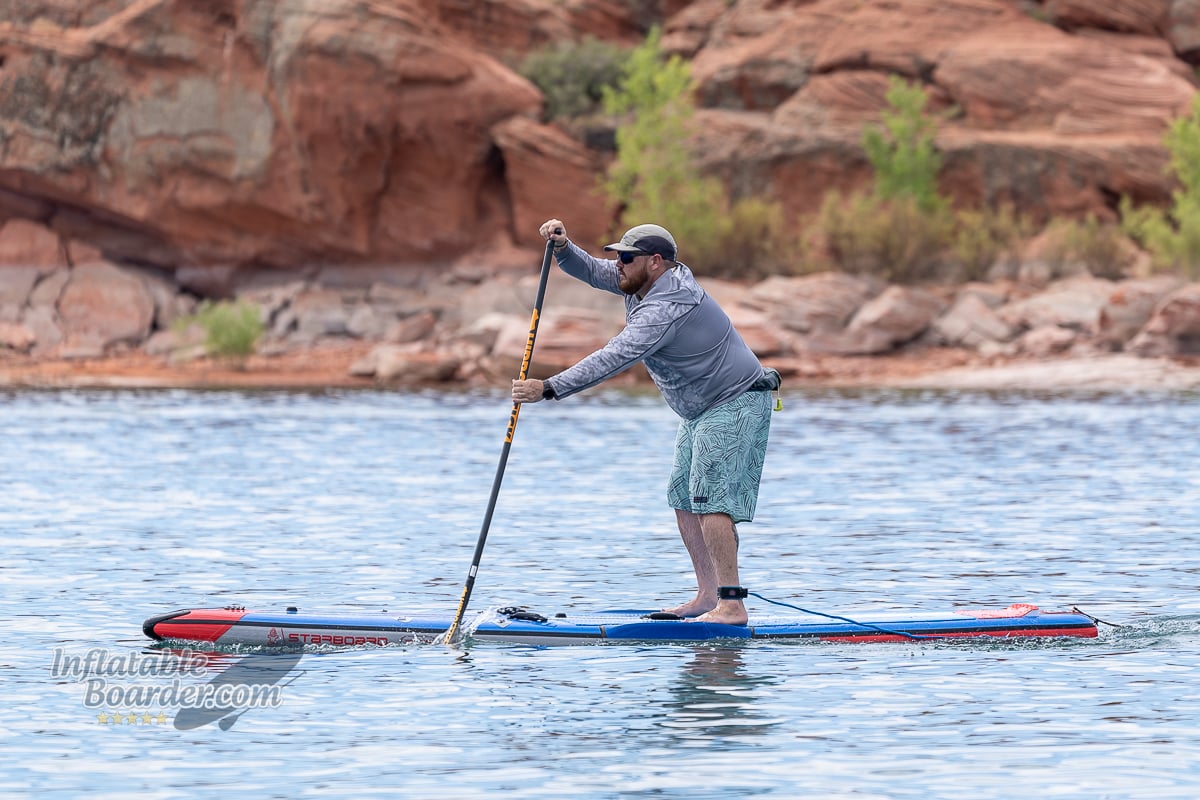
Choosing the right size paddle board is a critical step in selecting the best board for you and your needs, but not all SUPs share the same shape. The actual outline and profile of the board can impact its performance on the water just as much as its size – even changing its stability.
Some shapes are better for speed, others for maneuverability. Even just the specific shape of the tail or nose can make a difference in how a board feels and behaves on the water.
With all of these different factors it can be hard to compare boards without trying them side-by-side. While we here at Inflatable Boarder do have that luxury, we understand that’s not the normal situation for most folks. By understanding how the shapes change the board’s feel and performance on the water you can get a really good idea if a specific paddle board will be the right choice for you.
General Size – Length, Width, and Thickness
While this article will talk a lot about the differences in paddle board sizes, I won’t be going into detail about what size paddle board to choose. For more information on choosing the correct size paddle board for you, check out our blog post on Choosing the Right Size Paddle Board.
Length and Width vs Stability and Speed
In the simplest terms, longer and wider boards will be more stable. They have more volume to support your weight and have more surface area in contact with the water. Small changes in width have a more immediate impact on primary stability than small changes in length. So the difference in stability between a 33” and 34” wide board of the same length is more noticeable than the difference in stability between a 10’6” and 11’6” board of the same width.
Secondary stability (how stable a board feels when it’s not flat) has far more to do with shape, though width and length do play into it as well. Length does have a bit more of an impact in this case, primarily because so much of the width of the board is out of the water when balanced on one side or the other.
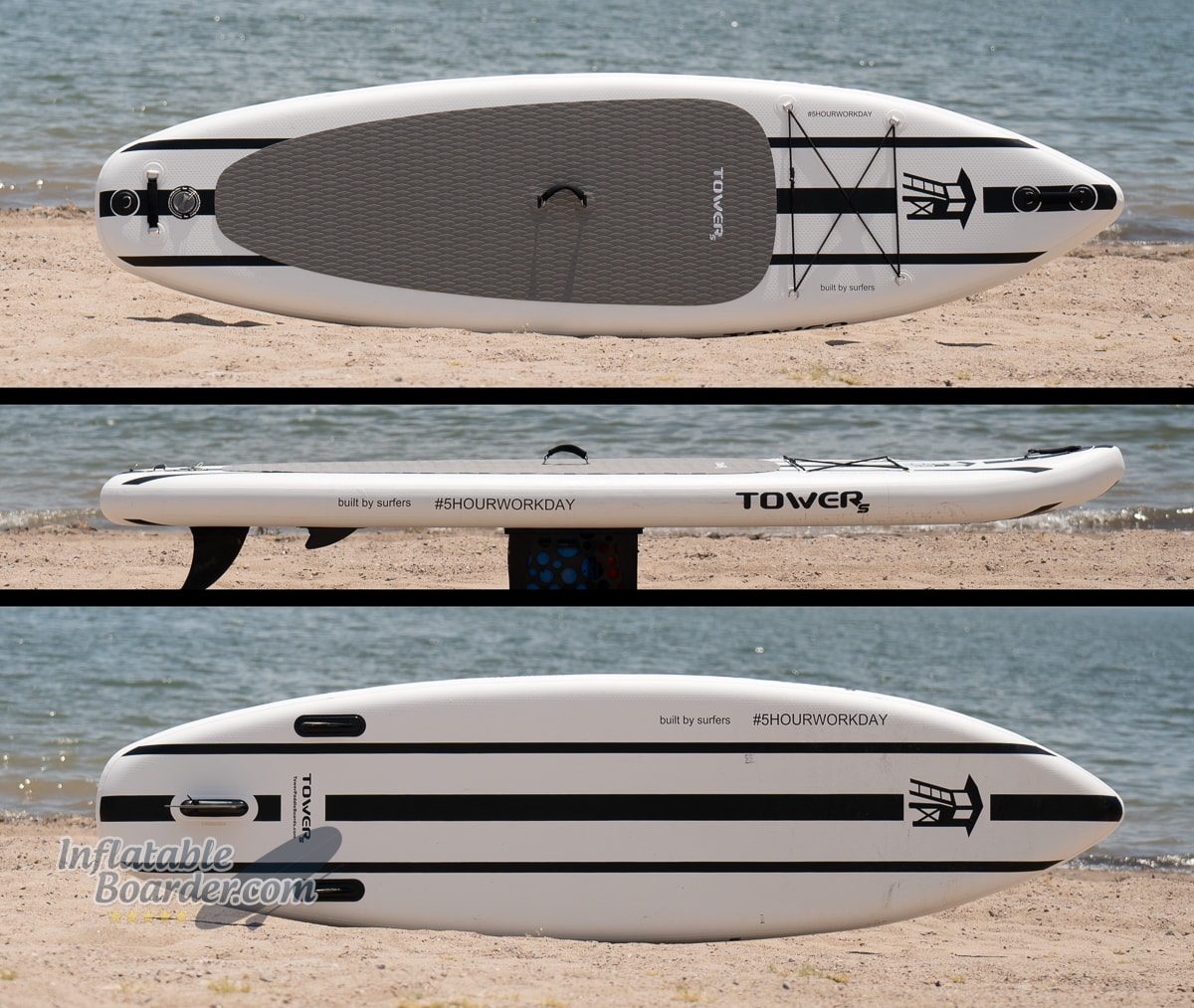
Length and width also impact speed. A narrower board has less cross-sectional area where the board and the water first interact. This means there is less of the board physically pushing through the water. It’s much easier to push a narrow board forward than a wide board. Length also has an impact on speed for two reasons. First (and simplest) is that longer boards resist turning better so more of your effort is put into moving the board forward rather than turning with each stroke. Second is the waterline and hull speed of the board.
Hull Speed is a calculated theoretical maximum speed for a watercraft where the length of the bow wake is equal to the waterline length of the craft. As you exceed a boat’s Hull Speed the boat begins to climb its own bow wake and is effectively moving uphill.
To move at any speed beyond Hull Speed requires an increasing amount of power input with decreasing returns*. Longer boards produce a longer bow wake and have a higher Hull Speed. It doesn’t mean you can’t paddle faster than this speed, but rather it takes an increasing amount of energy for each additional unit of speed. But, the Hull Speed is the fastest speed you can paddle with the greatest level of efficiency.
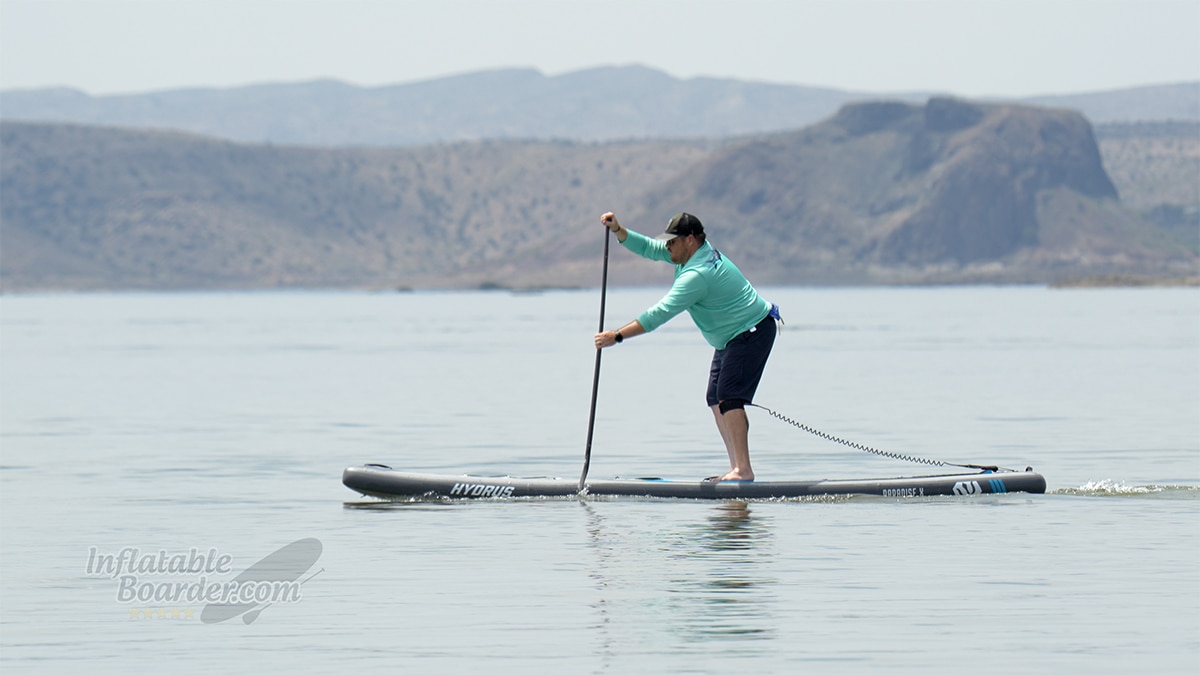
For example, the Hull Speed of a 12’6” touring iSUP with a 12’ waterline (due to the nose rocker) is 5.34 MPH. However, It is very possible to paddle a 12’6” touring iSUP at speeds in excess of 6 MPH. It just takes significantly more energy to make those gains over the maximum hull speed. A 10’ iSUP with 9’6” of waterline (due to nose rocker) is only 4.75 MPH. Again, you can paddle it faster, but each extra unit of speed takes more and more energy to achieve.
For the curious among us, you can calculate your SUP’s Hull Speed by multiplying the square root of the waterline length by 1.54 (or just use this online calculator)
*Until you reach a speed at which the boat is actively planing, at which point the boat and bow wake no longer interact in the same way and Hull Speed becomes moot. However, SUPs do not reach high enough speeds to actually plane out for more than a split second at a time.
Length and Width vs Maneuverability and Tracking
Every design choice for a paddle board impacts its performance in one way or another. Length, width, and shape also affect a SUP’s maneuverability and tracking.
If you were able to split your paddleboard down the middle and paddle perfectly straight along this midline, you’d be able to paddle perfectly straight without the need for any steering strokes to keep you on course (assuming no wind or waves change your course for you). The farther you move the paddle away from this imaginary midline, the more turning force you impart on the board with each paddle stroke.
Wider paddle boards will always force your paddle to be farther from the midline than narrower paddle boards, making it more difficult to track the board straight without steering input (and vice-versa).
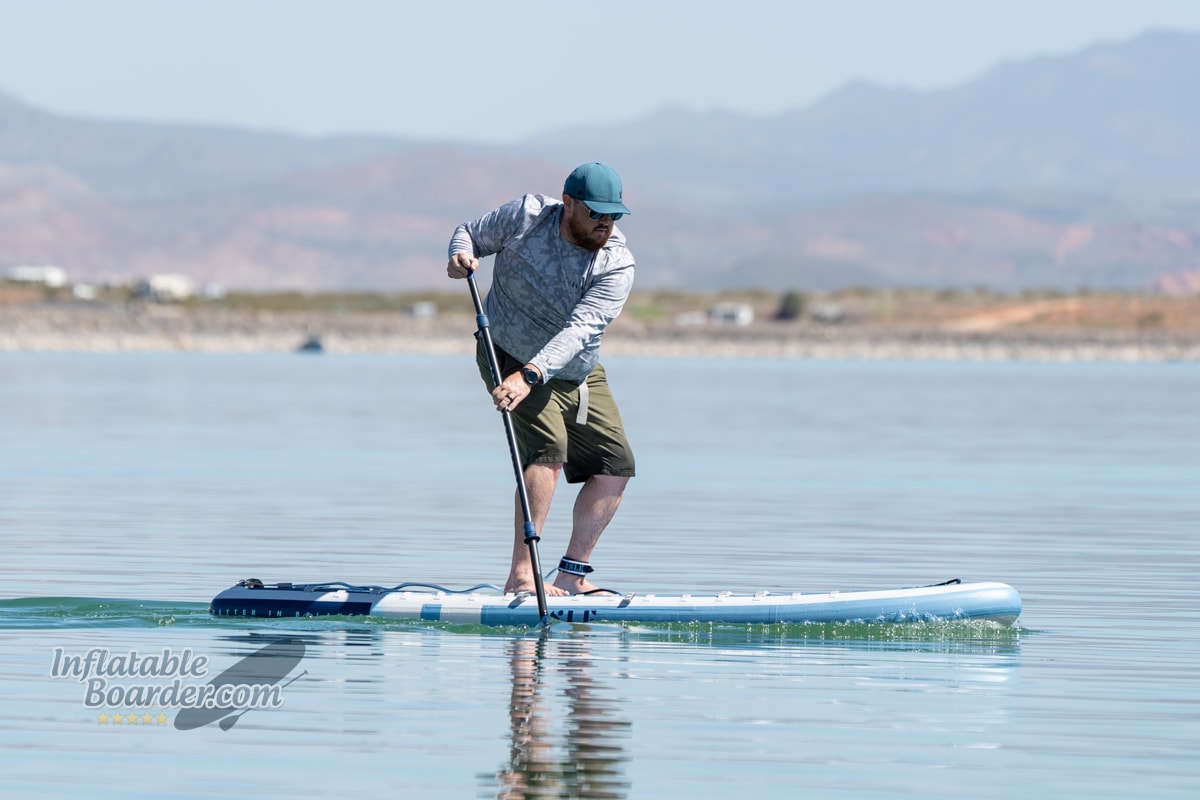
Length also plays a role in this agility and tracking trade off. If you imagine your standing position is the pivot point of your paddle board, a longer SUP will have more board in the water farther away from the pivot point. This gives the board more leverage to resist the turning forces from your paddle stroke. The shorter the board, the less leverage it has, and the easier it is to turn.
As a secondary impact of increased tracking, the less effort you have to use to keep the board moving straight the more of your effort can go into forward propulsion and speed. So a better tracking board will also be a faster board.
Thickness
iSUPs primarily come in two thicknesses: 6” (standard) and 4.7” (thin). The thickness of a board will directly affect two things, which affect everything else in turn!
With all other construction elements the same, a thicker iSUP will be more rigid than a thinner iSUP. More rigid iSUPs typically feel more stable. However, a thinner iSUP lowers your center of gravity, making it feel more stable as well. On the opposite end of the spectrum, extra thick iSUPs (8”) can feel very rigid, but may raise your center of gravity and/or have too much volume and can feel corky on the water.
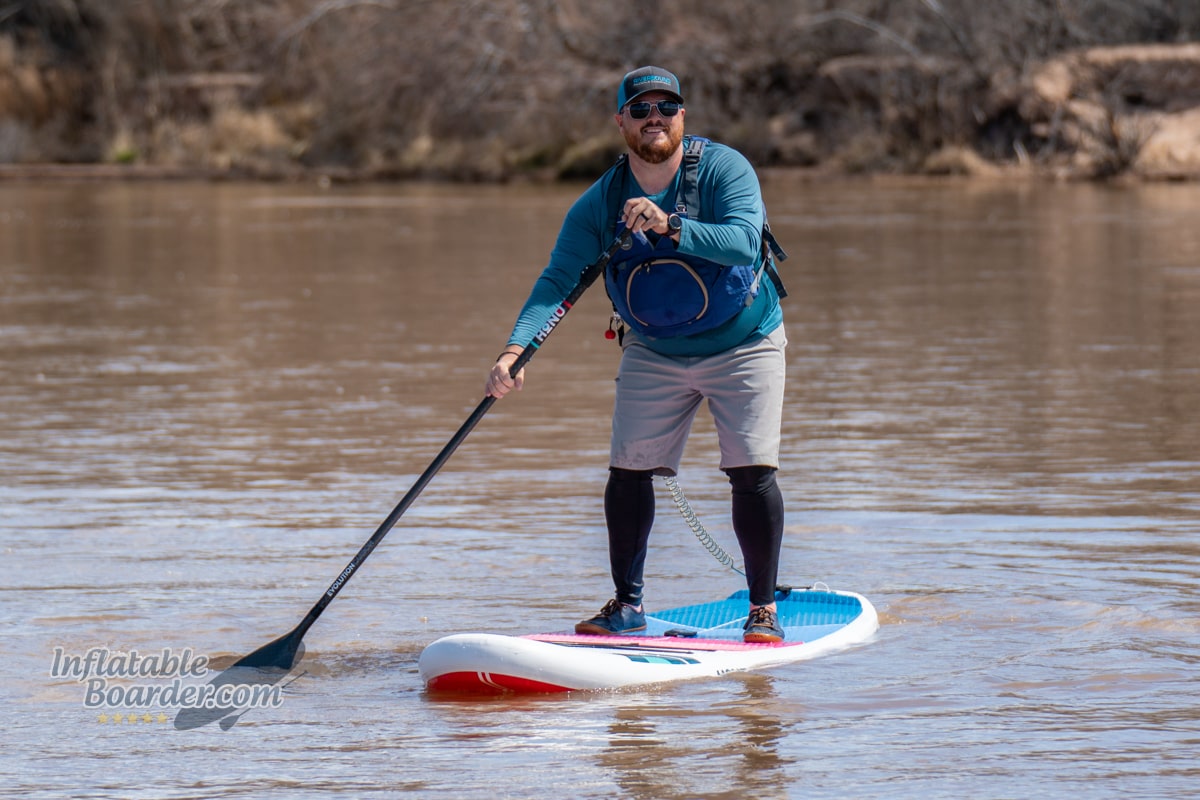
Rigidity can affect performance on the water. A board that isn’t rigid enough will flex and bend causing it to be slower and have poor tracking compared to a more rigid board of the same size and shape. Too much flex can also make a paddle board feel less stable.
Nose, Shoulders, Midsection, Hips and Tail
All paddle boards can be divided into five sections along its length. The Nose, Shoulders, Midsection, Hips, and Tail. With different combinations of shapes across the board, an iSUP can look like a rectangular mat, an egg, a torpedo, or anything in between. The shape of these sections and how they interact with each other greatly impacts how a paddle board behaves on the water.
Nose Shapes
The very front of the board, or the nose, is the first place the board interacts with the water when moving forward. Here, inflatable paddle boards are slightly more limited in exact shapes compared to the completely moldable construction of a hard SUP.
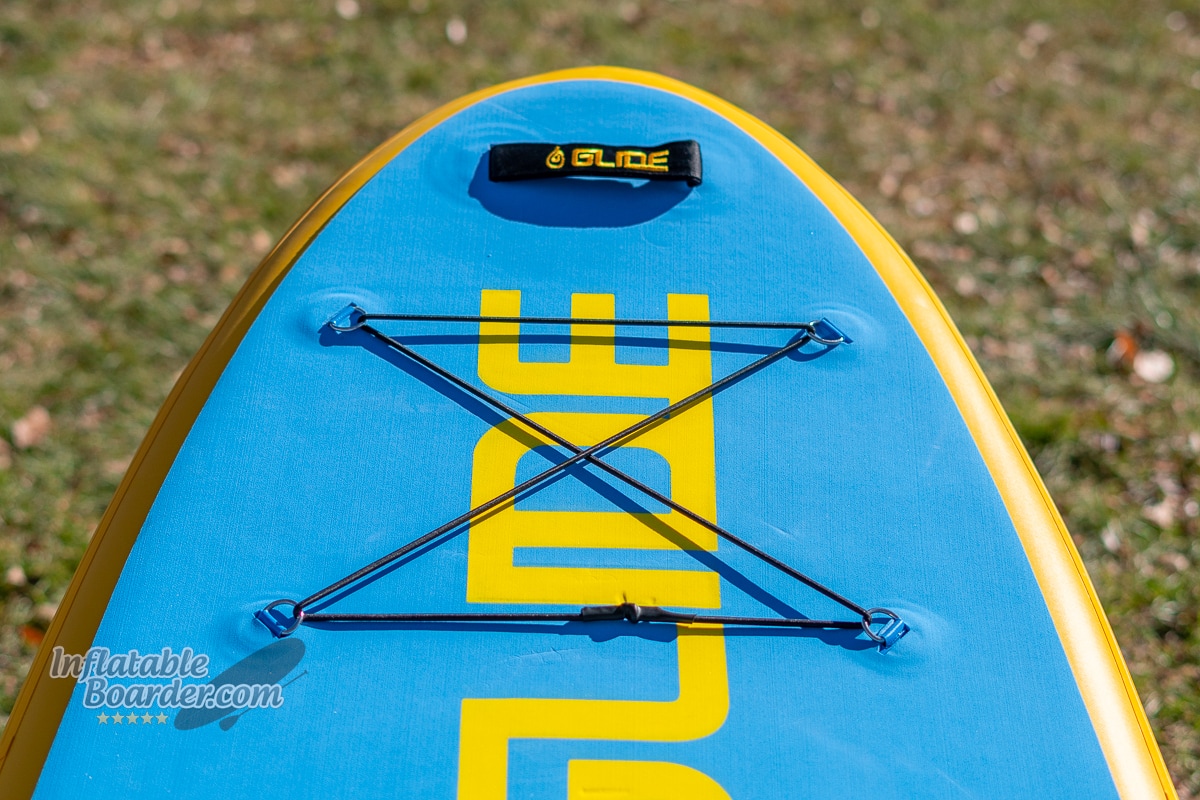
Generally the nose is one of three shapes. Rounded noses provide the most stability by keeping the board as wide as possible up front. This is great for all-around boards, smaller surf boards, and boards that prioritize stability, capacity, and maneuverability.
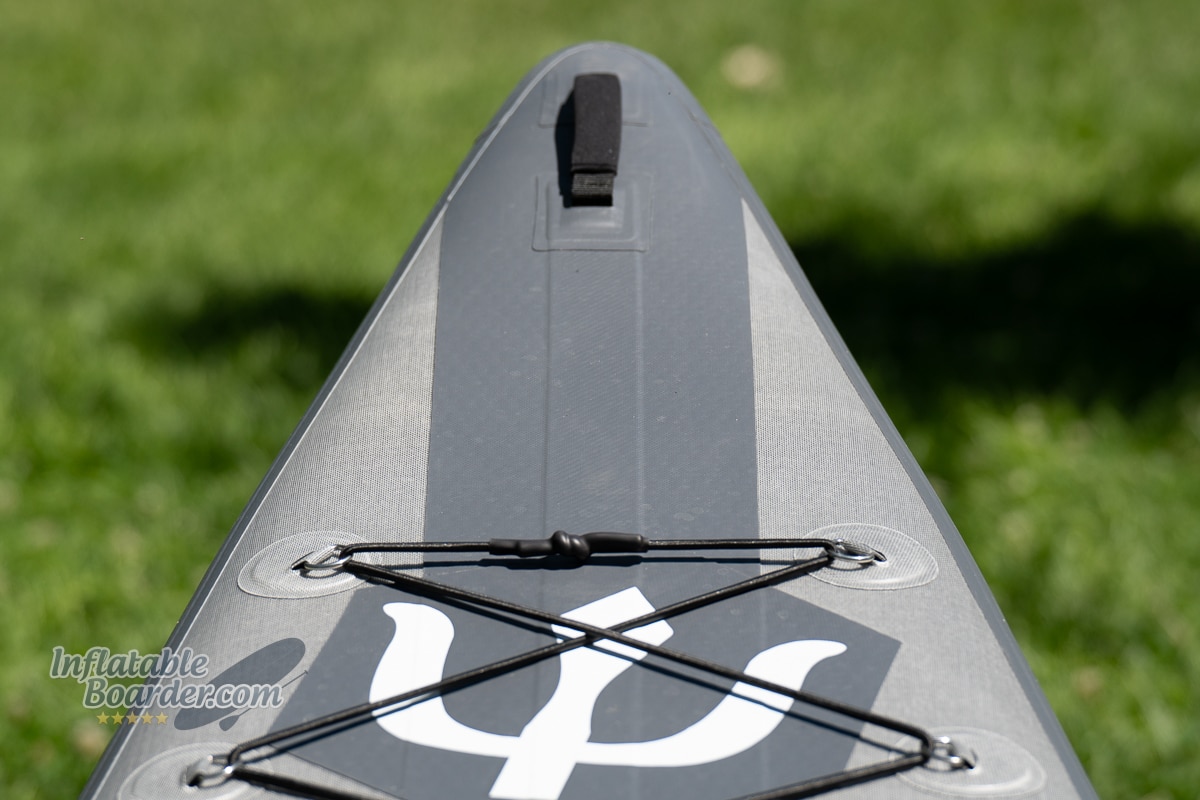
Narrow Pointed noses can help promote efficiency. Pointed noses can help more cleanly part the water with a smaller cross-section at the front of the board and punch through choppy conditions. Both can help a paddle board track straighter, but it also depends on how much rocker is present in the nose (more on that below).
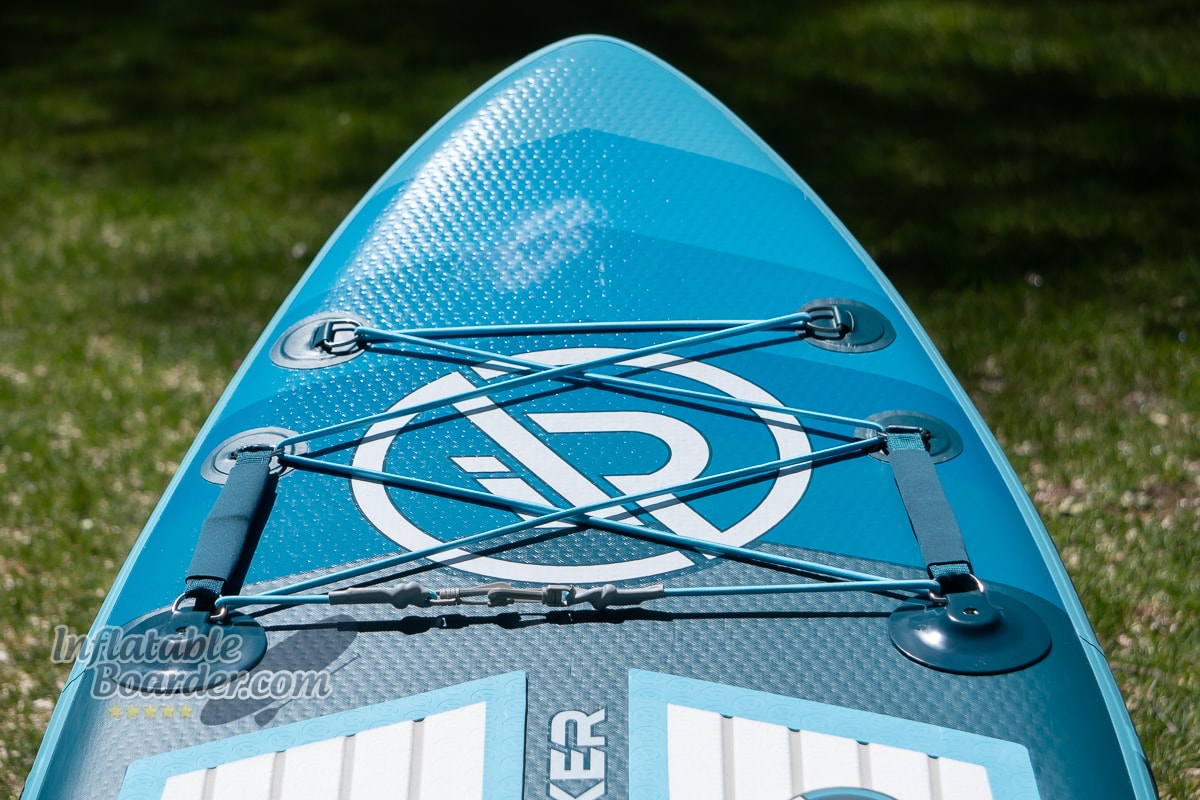
Hybrid noses are generally kept wide with a broad triangular shape to blend the benefits of both – some extra stability and some better efficiency. Generally these nose shapes are found on all-around boards and hybrid all-around/touring SUPs.
How much the nose shape fully impacts the board’s performance also depends on the rest of the board’s shape.
Shoulders, Hips, and Midsection
Where the nose meets the midsection and where the midsection meets the tail are the Shoulders and Hips. Shoulders and Hips can be abrupt, nearly forming a corner, or they can be completely smoothed out in a continuous curve. The midsection can be completely parallel like a box, or completely round like a football. Typically more parallel midsections have sharper hips and shoulders, and more rounded midsections have smoother hips and shoulders, but there are exceptions to every rule.
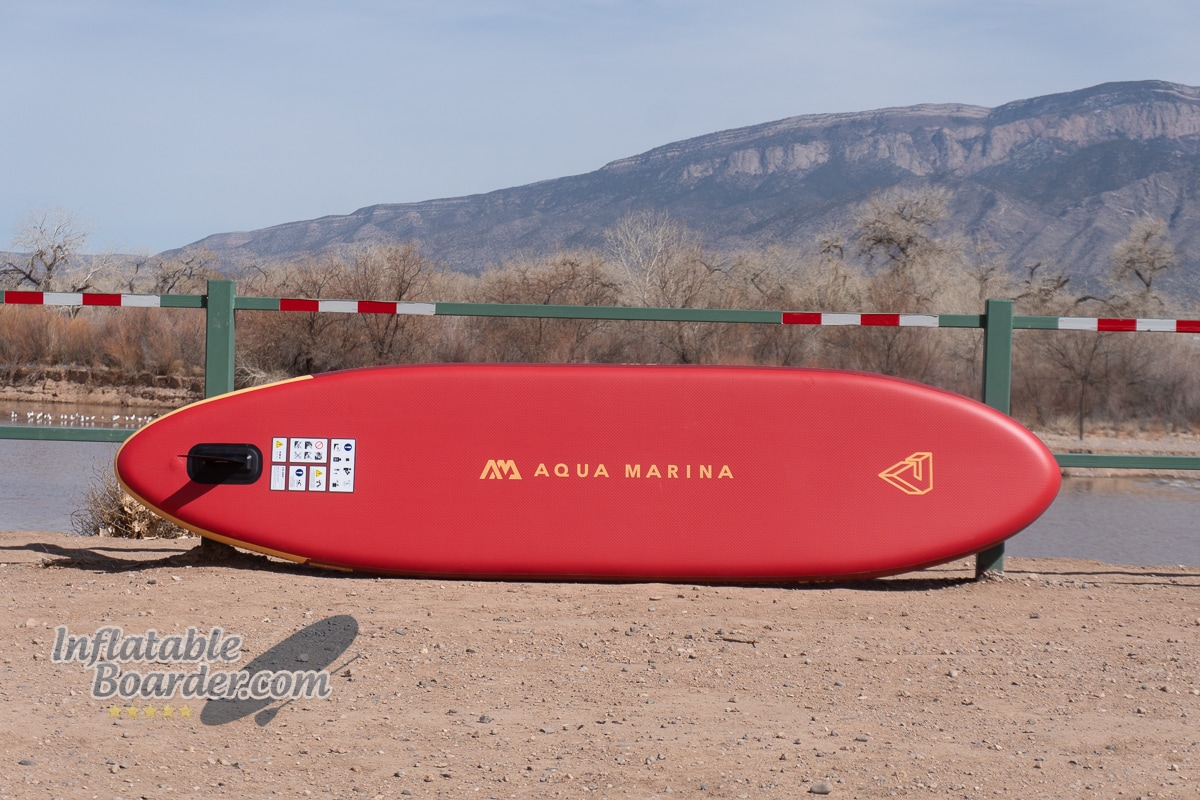
Sharp hips and shoulders create hard transitions in volume through the board. If you are standing on the wide midsection and then step back across sharp hips you will feel a very noticeable change (loss) in stability. Boards with smoother transitions in shape will have smoother transitions in stability. The same is true with the shoulders when moving (or placing weight) on the front half of the board.
Hard and Soft hips and shoulders also change how the board interacts with the water. Harder, corner-like transitions can create high pressure areas in the front of the board and drag-inducing vortices at the rear of the board. Smoother shapes allow the water to flow across the board without interruption.
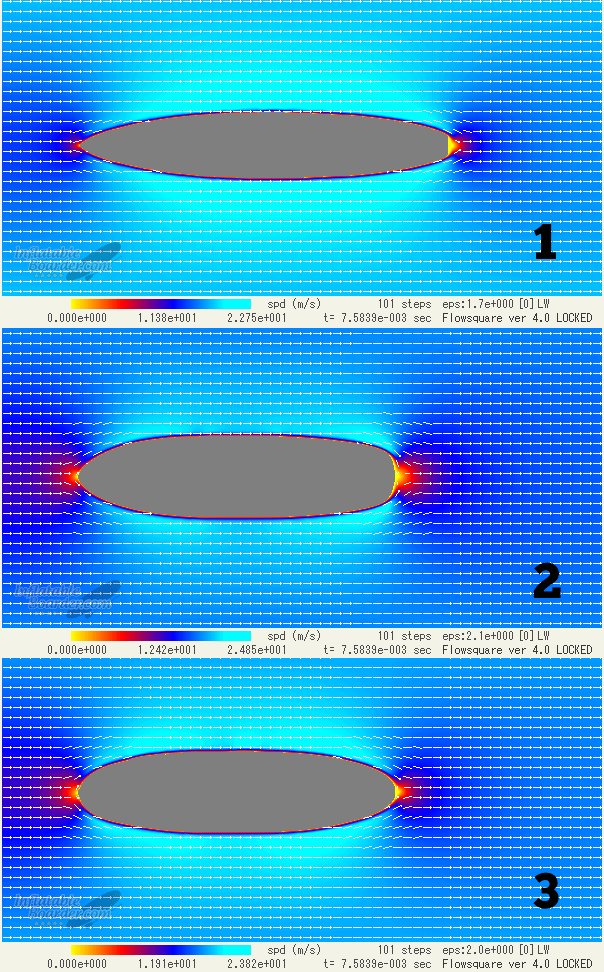
The midsection of the board falls somewhere on the shape spectrum between fully parallel sides (like a rectangle) and fully rounded sides (like a football). Parallel midsections provide the most volume and stability, even if you aren’t standing right at the middle of the board. Rounded midsections provide the most stability right at the widest point, but begin losing volume and stability immediately fore or aft of the wide point. In order to achieve the same feeling of stability, round shape iSUPs generally need to be wider than more parallel shape boards.
Tail Shapes
Your paddle board’s tail is the last part of the board that interacts with the water, but it definitely makes an impact on how it performs. Like the nose there are three basic shapes for SUP tails – Square, Pin, and Round. Of course there are other, less common, shapes and SUP tails come in a large variety of sizes.
Wider tails carry more volume and have more area on the water, so they provide more stability. But wide tails can create more drag, especially depending on the shape.
Square tails – particularly wide square tails – provide the most stability as they carry the most width all the way to the end of the board. They also create the most drag at the tail of the board without some very specific features.
Pin tails come to a very defined point. They are the narrowest of the three basic shapes, provide the least stability, but also create the least amount of drag at the tail of the board. They can also be used more effectively to engage the face of a wave for surfing or downwind paddling.
Round tails fall between the two and their amount of stability and drag is largely dependent on how wide the tail is. Tail width and Nose width are both traditionally measured 12” from the end of the board. So a round tail board with a 20” tail width will be 20” wide one foot from the end, but narrower at the very tip.
Rocker
In addition to the overall shape (also known as the outline or plan shape), SUPs also have a rocker profile – how flat or curved the board is vertically from nose to tail.
Almost all paddle boards will have some degree of rocker. iSUPs traditionally have some nose rocker, but no tail rocker. However many SUPs, including some iSUPs will also have some degree of tail rocker. Both of these shapes can be done with “kick” rocker where the board shape is flat and then suddenly turns up, or with “progressive” rocker that has a long, smooth (or continuous) change from front to back.
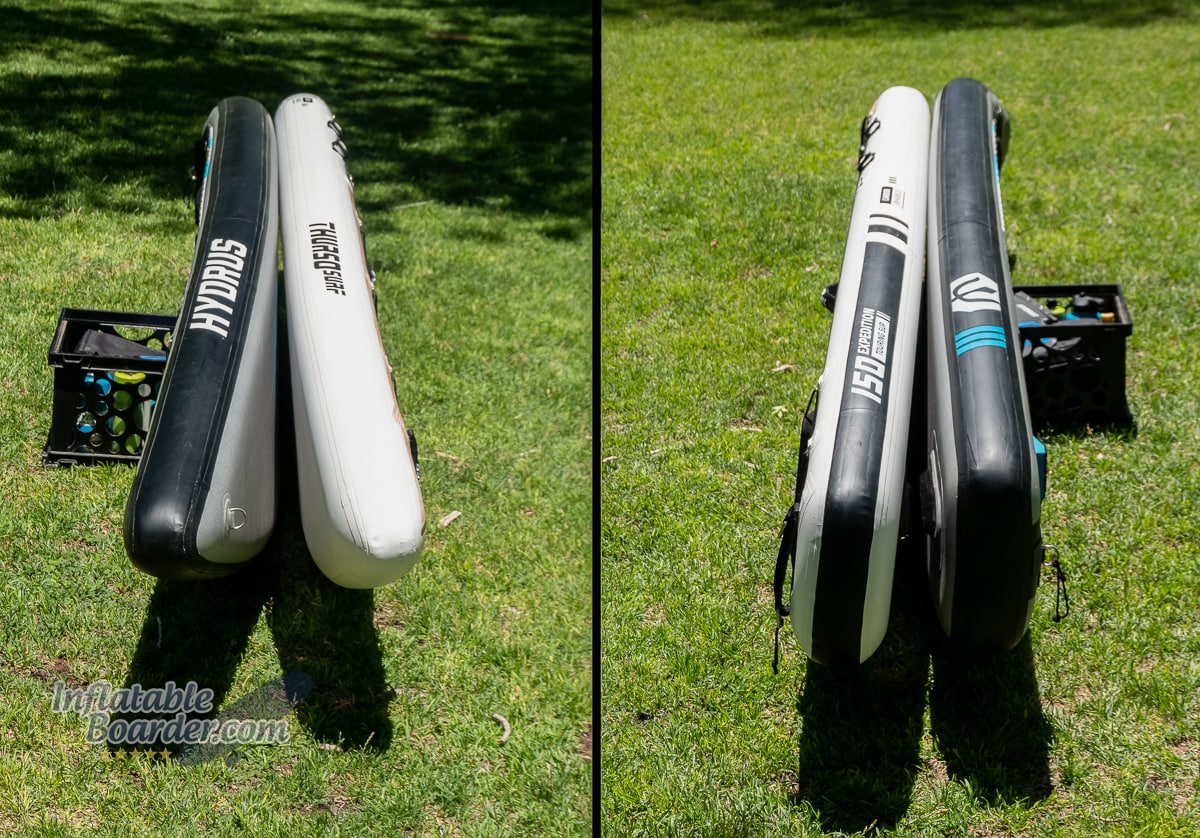
Nose rocker allows paddle boards to ride up and over choppy water. The amount of nose rocker will determine how easily it can do this, but too much nose rocker unnecessarily reduces the water line length of the board. This reduces tracking, improves maneuverability, and can increase the cross section of the board that interacts with the wind and water. Large amounts of rocker can also reduce stability as it lifts more of the board off of the water.
Tail rocker is typically used specifically to increase maneuverability and allow the paddler to easily change the plane of the board when surfing or downwinding (more easily lifting the nose to prevent pearling).
Whitewater SUPs generally use large amounts of nose and tail rocker to increase maneuverability and aid in traveling over large waves and holes. Racing SUPs tend to have low or no rocker to increase waterline length (and hull speed) and tracking ability.
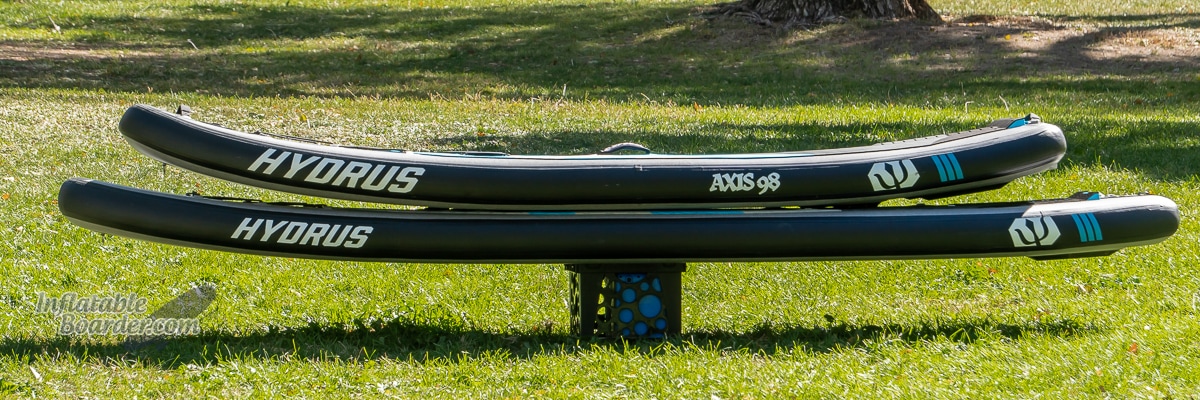
Hull Shapes
Hard paddle boards can be shaped in a variety of ways from nose to tail, including with intricate shaping along the hull, or bottom, of the board. iSUPs don’t have as much customizability in the details of their hull shapes. However, newer technology is allowing iSUP shapers more and more freedom each year.
The baseline for paddle boards is to have a flat hull. Even the fastest carbon fiber paddle boards on the water will have, essentially, a flat hull under all but the nose of the board. Flat hulls provide far more stability than a rounded hull of the same width. Rounded hulls freely roll from side to side with little resistance, but a flat hull does not. This rolling from side to side (or lack thereof) is called primary stability. Flat hulls also allow a paddle board to momentarily plane when paddled at very high speeds or when surfing a wave face.
Round hulls, though, evenly displace the water they move through and also allow water to easily slide past the hull. Round hulls under the nose of a board let water move under the board without “catching” and pushing against a flat side of the board. This is mostly beneficial when paddling in cross-chop conditions.
Almost all iSUPs have a flat hull from nose to tail. However, there are some companies that have devised a few ways to manipulate the drop stitching to allow for more detailed shapes. Red Paddle Co and Sea Gods both have iSUPs that feature a rounded hull design under the nose of the board. They accomplish this with some clever cutting and joining of their materials to allow the nose section of the board to inflate more like a balloon while keeping the top flat.
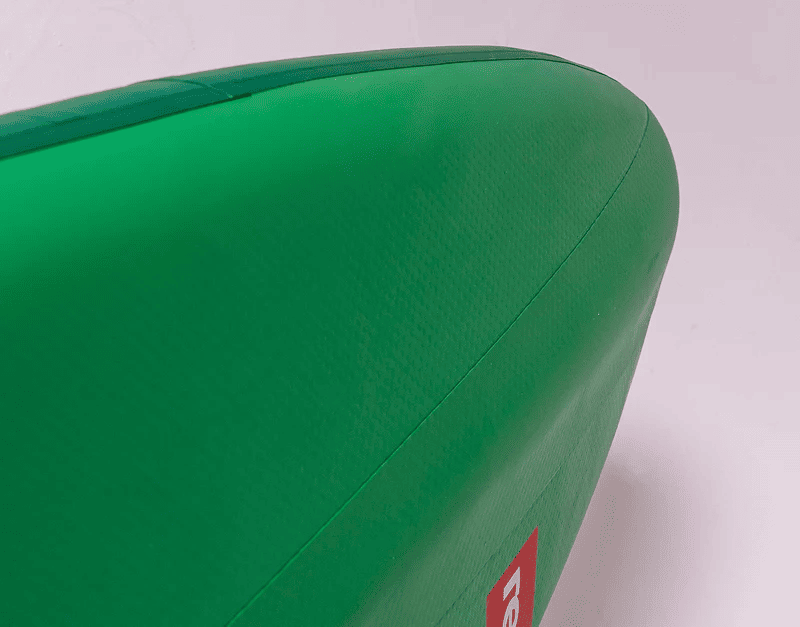
Red Paddle Co also features a short ventral fin on the nose of some of their boards that is designed to break the surface tension of the water and provide a small boost in tracking. How effective this nose fin is will depend entirely on the water conditions, though.
Starboard has recently released a series of iSUPs called the iCON that manipulates the drop stitching along the midsection rails of the board to imitate a concave hull shape. Concave hulls can provide additional stability, like the double hull of a catamaran, and in some cases they can provide additional lift to help a board plane easier. In this case the change is primarily for stability as the hull remains flat through the middle of the board, but has expanded sides.
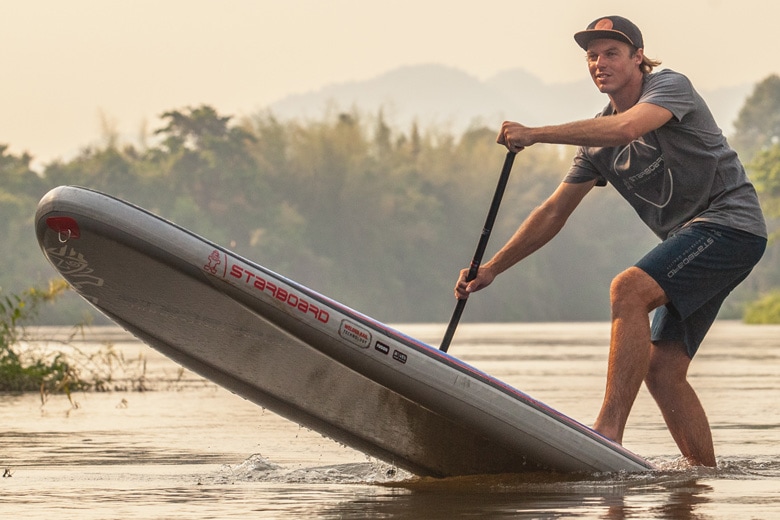
Lastly, some iSUP builders have designed boards with more exotic tail shapes. Stepped tails, swallowtails, and fish tails and other exotic shapes are made by a few iSUP makers for boards designed for surfing. These shapes can be very effective for specific purposes on hard boards, but tend to be less effective with the 4.5-6” rounded rails of an iSUP.
Displacement vs Planing Hulls – Let’s Bust a Myth
I’ve mentioned planing and flat hulls and round hulls already. There are two generic types of watercraft. Those with planing hulls and those with displacement hulls. The difference is how they interact with the water. Displacement hulls move through the water, displacing it in front of them as they go, and Planing hulls ride on top of the water. In standard boat design a planing hull will be more flat and a displacement hull will be more round (or V-shaped).
However, even fully flat planing hull boats do not plane until they reach a certain speed. Until they reach that speed they still operate as a displacement hull watercraft.
The only time a paddle board can actually reach planing speed is while surfing and for extremely brief periods of time at the peak power output of a paddle stroke by top SUP athletes. Paddling cannot generate enough speed on a SUP for continuous planing. Board designers know this, which is why the lightest, fastest, most-winning racing SUPs are designed as optimized displacement hull boards.
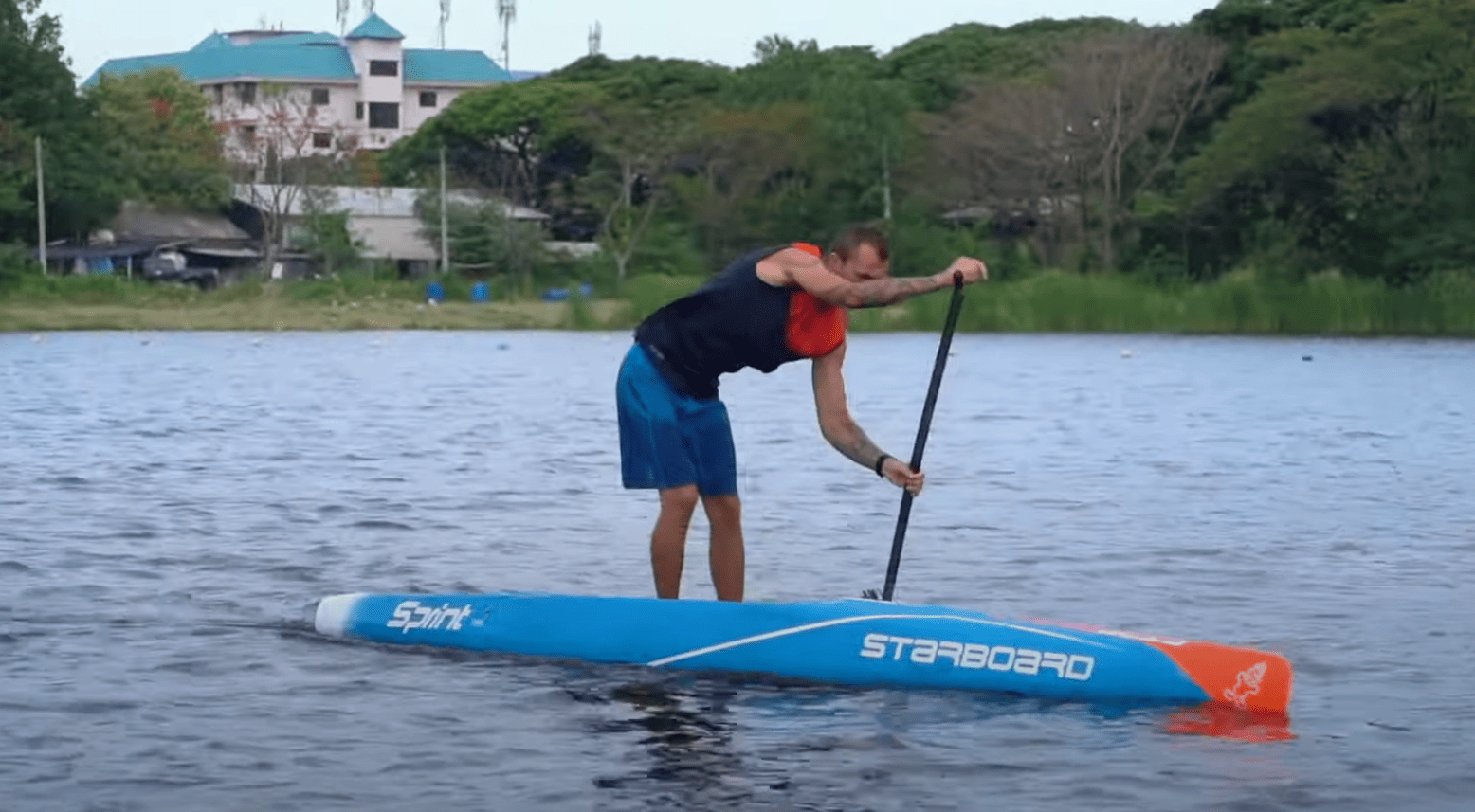
With that in mind, all SUPs – inflatable or hard – are displacement hull vessels. They push through the water and generate a bow wake. They do not travel fast enough, nor with consistent enough speed, to actually plane on top of the water.
The terms “displacement hull” and “planing hull” are sometimes used (albeit incorrectly) to describe the shape of the board, or part of a hull, on a SUP. Generally, “displacement hull” SUPs will have a round or V-bottom under the nose which then flattens out before the standing area. The term is also often used (incorrectly, again) to describe narrow, pointed, noses on SUPs.
“Planing hull” SUPs will maintain a flat hull shape through the nose, and often have rounded or hybrid nose shapes. The same term will be used for boards that have more nose rocker that lifts up above the water rather than sitting in the water. In flat water, the nose has no interaction with the water, and in choppy conditions it pushes through the water.
The biggest performance difference between these nose styles is in their tracking and how they shed and allow water to move across them. Pointed noses that are in the water (if it’s rockered out of the water it doesn’t matter what shape it is) aid in tracking, but can also be more easily pushed around by waves/wake moving across the board. Round noses that are rockered up from the water make a board more maneuverable and allow water to more easily slide under the board (riding up and over through chop rather than pushing through it).
Final Thoughts on Paddle Board Shapes
There is a ton that goes into the design of a paddle board, both technically and aesthetically. Very minute changes in board shape and size can change how a board feels and performs on the water. However, it’s also important to know that minute changes are mostly only noticeable when directly comparing two boards at the same time.
General shapes and sizes perform generally similar. That’s why we know that long skinny SUPs are faster, but less stable and less maneuverable than wider, rectangular boards. But, when deciding between two different models, those small changes in how the lines flow together, how the board interacts with the water, and how the shape of the board changes stability all matter. That’s why we focus so much of our reviews on the technical side and performance side of each board.
What other questions do you have about paddle board shapes and sizes? Let us know in the comments below!
